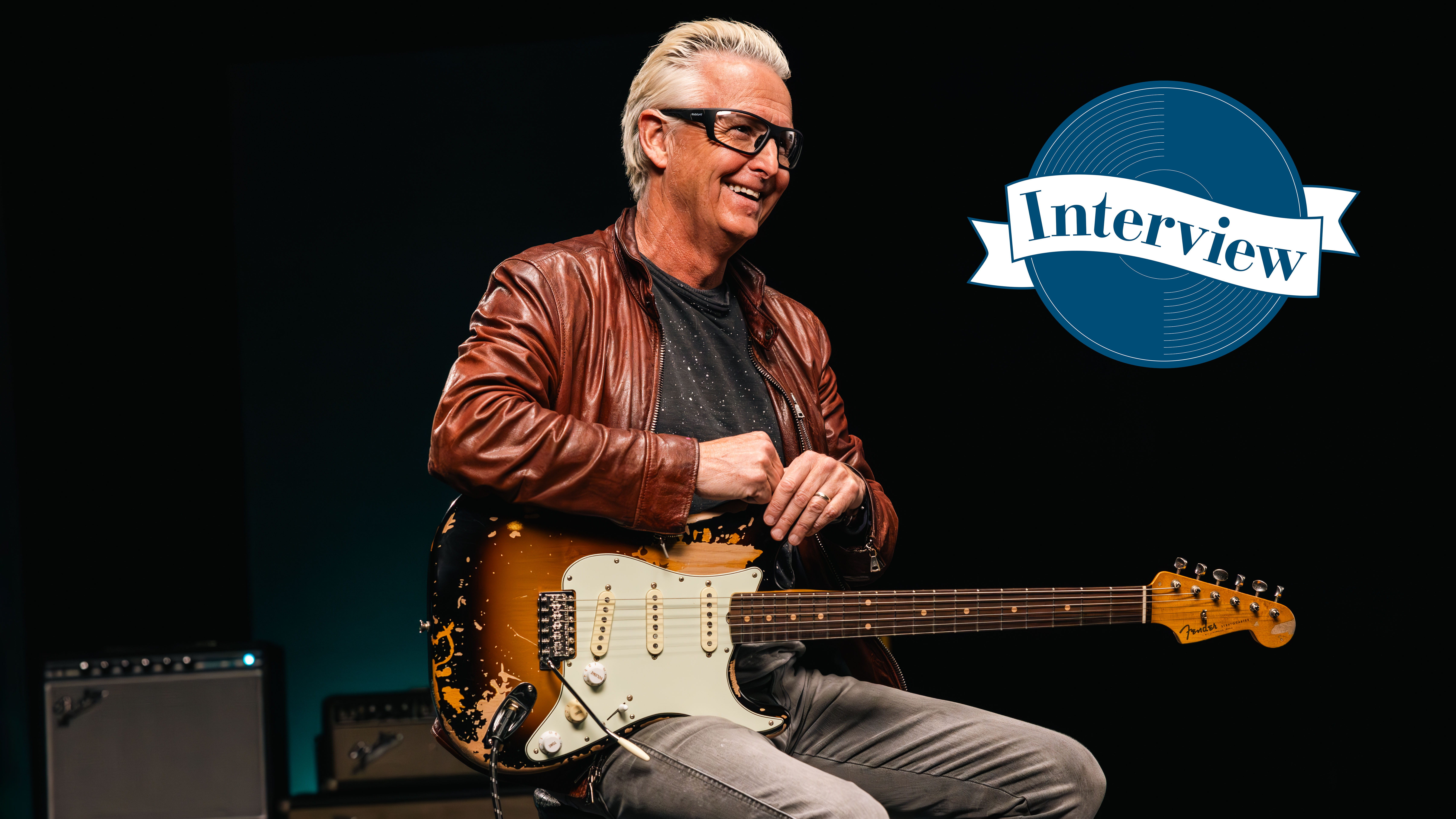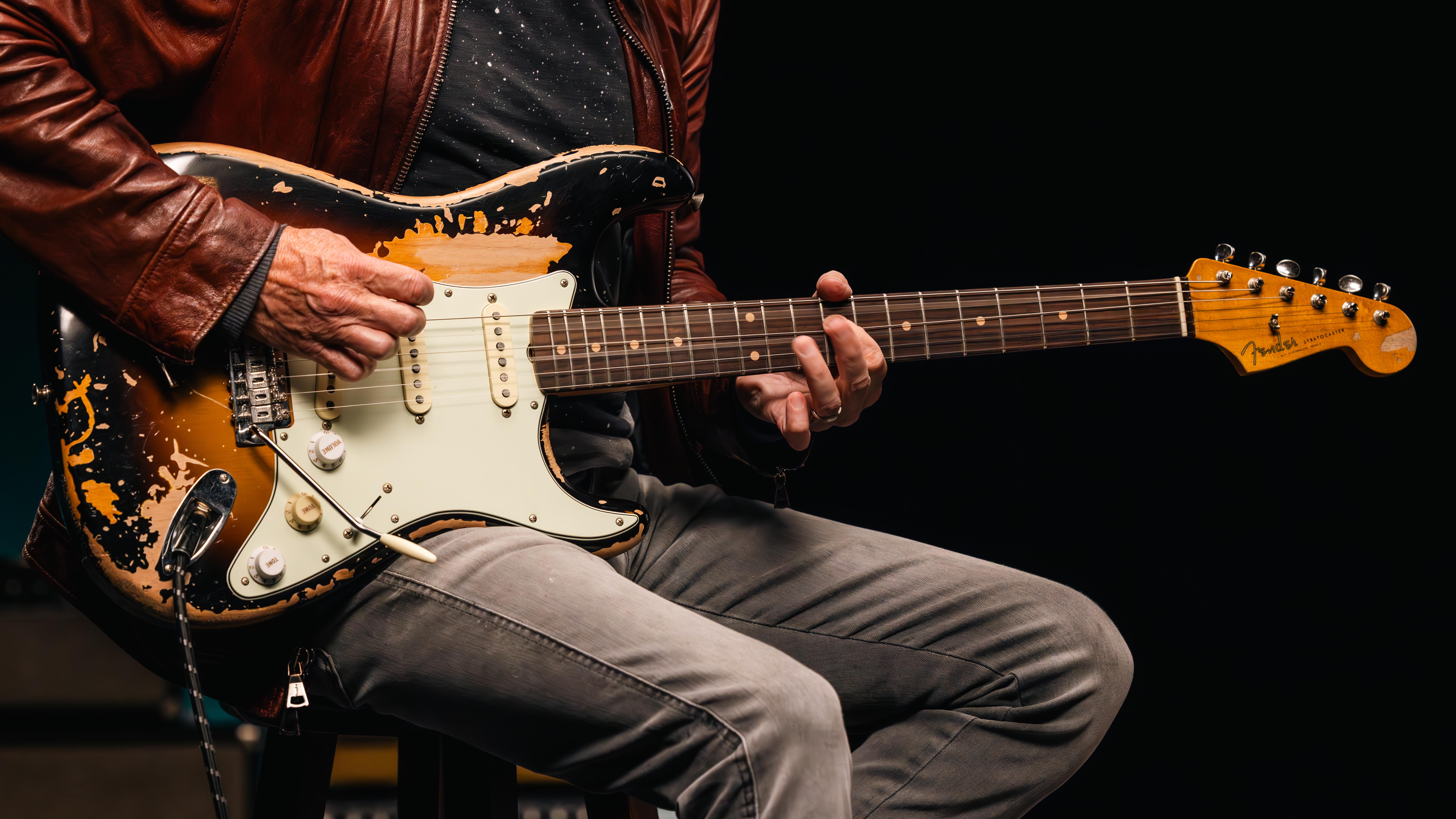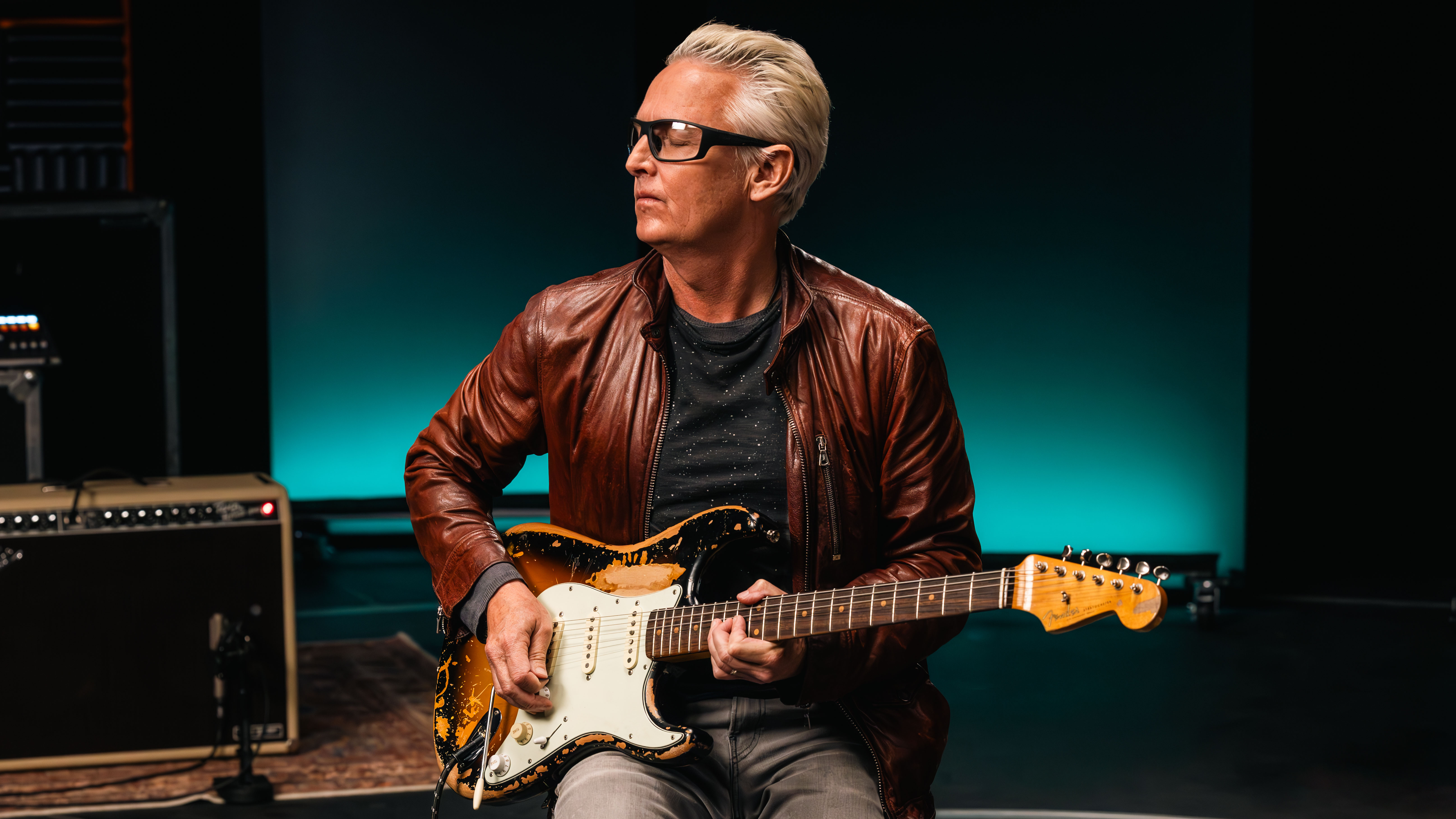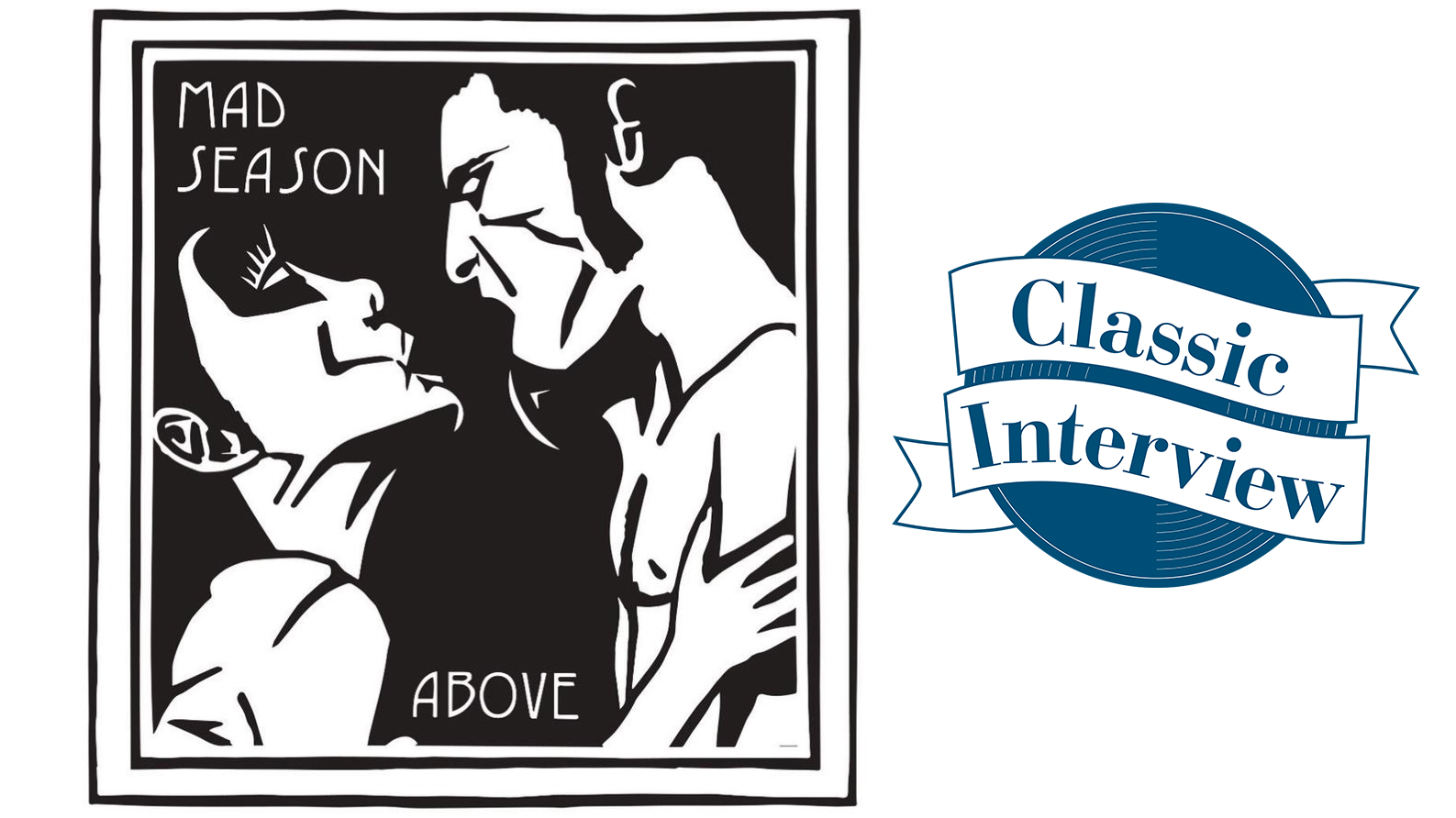Interview: Mike McCready on road testing his new signature Mexican Strat at Pearl Jam shows, their next album and why he's still learning Eddie Van Halen's Eruption

If Mike McCready's Strat looks like it's seen some action then consider it was already 30 years old before he used it for over 1,000 Pearl Jam gigs and every studio album after 1991's Ten. For years he thought it was a 1959 model (McCready owns a few choice guitars from that year including a Les Paul 'Burst and even has a tattoo of the number 59) until his crew had to break the news it was actually a 1960 model.
In 2021 the Fender Custom Shop painstakingly recreateda limited number of $15,000 versions of the guitar McCready has played fan favourites on since the early '90s, but now we have a model many more of those fans might actually be able to save for. Made in Fender's Mexican factor Ensenada, this Road Worn model is ambitious; recreating the wear to the Pearl Jam guitarist's exacting specifications in look and feel. Because nobody knows the original better.
In the midst of a US tour with the band, we talked to Mike about the challenge and appeal of the new model, why the Strat is such an important instrument for him, and what's next for Pearl Jam and beyond.

Ten years ago I spoke to you about the reissue of Mad Season's above and you mentioned that you'd spoken to Fender the year before, in 2012, about the possibility of a signature Strat. Even then you said it was really important to have a model more fans could afford, so this has been a long time coming.
"A long time. I didn't realise it was that much of a long time coming but [Fender] put out the more expensive model a couple years ago, and that was very exciting and fun. But initially, along with that deal, I always wanted to do a model that was not as expensive so people could afford it. Because I remember what it was like to not be able to afford a guitar when I was a kid.
"I flipped burgers and saved up $600 to buy a Kramer Pacer over a year and a half. So I remember those days and initially, I wanted it to be cheaper than it is now. But then COVID happened, as we all know, and prices went up, and all these things that happened. But we've kept it as affordable as Fender can achieve. And it plays magnificently. I've been playing on the road and it sounds great."
You've been road-testing it at shows?
Want all the hottest music and gear news, reviews, deals, features and more, direct to your inbox? Sign up here.
"I have been and since I was going to talk to you, Rob, I wanted to make sure I was playing this thing live so I could have the confidence to go, 'Oh yeah it's something that's worth buying'. I played it on Indifference, I played it on [Yellow] Ledbetter, Daughter… I've played it on six other songs. Strat-type songs, just to see if it can hold up to what my real 1960 does. And it does."
That's great to hear. This seems like the most ambitious electric guitar the Mexican factory has produced to date, and the appeal of a model based on an early '60s Strat obviously goes beyond your fans. What were the key features this version of the guitar had to get right for you?
The original sounds the best, I'm not gonna lie, because that's the original, but this one is right next to that
"The neck had to be perfect on it, and the finish on the back of it had to be kind of sanded down. I don't like tonnes of finish on the neck – my hands get stuck on it. So this one had to feel like playing a guitar of 30 years was like. So they accomplished that by sanding it and doing whatever magic they do to that.
"The pickups had to sound as close as they possibly could to the ones on my 1960 original. The original sounds the best, I'm not gonna lie, because that's the original, but this one is right next to that.
"Last year when I was touring in Europe we had about three prototypes of this Fender going and I was playing them there to [judge], [I'd say] 'The pickups aren't right on this one but on this one they're a little bit better, and that's not as good a neck but it's good on this one', so we ended up working with Fender very quickly, they're very easy to work with. We ended up [combining] those three together and that's what we have now. It's the one out of those three."
I saw you play at Hyde Park in London over two nights last year so you were probably playing one then?
"You probably saw me play it on one of those nights or both. I'm sure I used it."
How does the fretboard radius on your Strat compare to other vintage examples of the same era that you've played?
"Initially, and this goes back to when I thought it was a 1959 for 30 years, and my crew and my tech didn't tell me this until we did this Fendor deal. So I always thought it was 1959 but I should have known better because I'd played '59s besides mine and the necks were always bigger, more kind of baseball bat-like. But I never put that together with mine. I was like, 'Oh, mine just has a thinner neck'.
"But the 1960 Strats have a thinner-type neck, and I have small hands so that's easier to play for me. I've played my 1960 model on probably 1000 shows. I've played it on every record, except for our first one, and it's just my go-to guitar. So this is an example of that go-to guitar, I hope – it feels like it to me."

Some guitar players disagree about relic'd guitars and the idea of artificially ageing but what often seems to get missed in the debate is not just about the way the guitar looks, but the way it feels. So this is a way of people getting close to how your Strat feels, not just looks. It feels played in.
Guitars have to play good the first time I play him or they never get better for me
"I wanted it to feel that way because that's those are my favourite guitars; the ones that have already been played and that people have used. So I was excited to go back and forth with Fender on it and go, 'No, the neck has to be a little bit this way or the finish has to be a little more looking this way'. And they were very receptive and quick to get back to me on that. George Webb who works for us as Jeff's [Ament] bass tech, but is also our warehouse guy, helped me go through the guitar minutely and look at it and say, 'Maybe this isn't right'… He's one of those guys that can see all that. I can't, I can see the overview [but] he saw the specifics.
"The relic'ing of it is kind of fascinating to me. I don't know how they do it. They don't tell me. I'm assuming there are a lot of secret methods. So it's kind of like alchemy in this interesting way to me that they make it look that way. I love that they do that. But I like guitars that play like they're old. That's what I gravitate towards. And they have to play good the first time I play him or they never get better for me. And this one does that for me. That was huge for me."

The new Strat has got the same chip in the headstock as yours too and there's some debate about how that occurred – could it have happened during the 1995 performance of November Hotel with Mad Season at the Moore Theatre in Seattle?
"I don't think so. What happened at that one is I think that one was my 1962 black reissue that Stone and Jeff bought me right after we first started playing [in Pearl Jam] and I destroyed it that night, which I'm sad about because I don't have it anymore. It was one of the first in a long line of guitars that I was breaking back then. So that that was the 1962, that wasn't the '59, sorry, the '59/'60 at that time [the footage below suggests Mike might be mistaken on using the '62 reissue for November Hotel at the Moore and it looks to be his sunburst Strat he's playing during the performance].
"I had it [then], I probably played it at that at that show. I'm sure I played it on River Of Deceit. I did play that Strat on that song on the record, specifically for that out-of-phase pickup [position 2]. Along with every other Pearl Jam record, besides our first one, I'd played that one on. But the chip happened, I think, in a show in Los Angeles at the Forum. I forget… but 20 years ago I was trying to take out a speaker and I went right in, not to the speaker but right on the wood of the edge of it and it just chipped right off. And I went, 'Uh, why did I do that?' I immediately regretted it. But I never got it fixed because it was just part of the charm of it, I guess."
How do you tend to utilise the five pickup positions of the Strat live – like the bridge pickup, for example?
"It's really important because when I'm playing and if I'm in the middle position and doing the rhythm part of a song, and then a lead happens, I kick it right into the treble [bridge pickup]. "I'm constantly moving back and forth, like very ADHD on my pickup selector. So a lot of times when a lead is about to happen, Even Flow is a good example, I'll flick it right to the most trebly [position], so it will come out screaming. I'm always looking for that high, screaming note. And that's generally on the treble pickup.
I'm going back and forth on the five positions through all the songs and they're different every time
"When I got my first 1962 Strat, it only had three positions on it so I had Mike Lull, whose company we do our guitars with [Mike passed away in 2020], put a five-position [selector in] so I could get the two out-of-phase ones – I think they're still called out-of-phase. So I could get that sound for Ledbetter – the more creamy sound for Ledbetter and Alive.
"I'm going back and forth on the five positions through all the songs and they're different every time. It's just kind of what I'm feeling. If I don't hear something, I go, 'Okay, I'm going to the next thing. Oh, there it is.' I'm chasing another sound."
When you're working with the band in the studio, and you're not sure where you're going to go with a track in terms of tones, is the Strat the guitar that you go for, because of those multiple options it gives you?
It's kind of the go-to guitar
"I think it's the one that I'm most comfortable with, that I've used the most. It's kind of the go-to. There are certain songs, if Stone [Gossard] is playing a Strat or Ed's [Vedder] playing a Strat, I'm probably not going to play a Strat on it, because I want to play something that's the opposite of what they're doing.
"As a band, I don't want everybody playing the same type of guitar because it's gonna sound too samey, and that's not good. So Stone will play a Les Paul, I'll play a Strat. Stone will play a Strat, I'll play a Les Paul – I'll mix it up. Then Ed throws in something… ok, now what do we do? I always want it to be complimentary, and different sounding than the other guitars that are happening in my band. But to answer your question; yes, I will grab that one first."
I wanted to ask you about Andrew Watt, who you've been working with on a new album. He's a producer, but he's also a guitar player, and a massive fan of Pearl Jam, which must be an interesting combination.
"Andrew Watt is known as a giant pop producer guy but he's a great guitar player. He comes from rock, that's where he cut his teeth. He loves our band, I think we're his favourite band – I know we are. He's told us.
Andrew went completely crazy and said, 'You're putting a lead of every single song'
"He pushed me in a direction for this latest album that we've done with him, that we're still doing, to do more leads – I'm doing leads on almost every song. And that hasn't been the case with Pearl Jam for a long time. If anything there's been songs [where's it's been], 'Don't put a lead on it' and sometimes I go, 'Well f*** I want to do a lead', it's sad. And sometimes it makes sense to not have one but it's kind of what I'm the best at. So I missed it for a few years, and a lot of records.
"So Andrew went completely crazy and said, 'You're putting a lead of every single song' and some of them have two. And that's what's happened and it's been really fun to do that again because it's given me the freedom to express myself where I haven't been for the last couple of records.
"He kind of kicked our asses. He kicked us to record quickly, got Matt Cameron to play more like he did in Soundgarden, in my mind. Matt Cameron's pushing this thing and it makes it sound more powerful than anything we've done in a long time."
That's really good news to hear. Like Soundgarden were, you're a band where every member writes songs. Has that process of pleasing everyone and making everyone feel like they've brought something to the table on a record got easier over time or is it an ongoing challenge?
We all come in with a myriad of ideas – basically five to 10 demo ideas
"I think it's always kind of a challenge. Because we all come in with a myriad of ideas – basically five to 10 demo ideas [each]. And one will get picked maybe from each one. And that's… you have to be kind of willing to let go and go, 'Well, maybe the next record I'll have a couple of songs on it.
"I don't know if it's gotten easier. I just get excited when one of my songs gets picked, and so I have to look at it that way. I'm grateful that we all get to write in this band, because it could definitely not be that situation. There are a lot of bands where that doesn't happen. So I'm totally happy where I'm at in this band right now, and have been for the majority of my career. So I feel very lucky I can write songs."
Stone did an interview a few months back where he suggested the band were in the latter stages of recording this next album, but are you still in that process, as it were?
"I think we're still kind of in it right now. We're touring right now so we're kind of in tour mode playing our other songs and more of the Gigaton stuff. I feel like… it's not done yet, the Andrew Watt session stuff. And it will be, and we'll put it out next year for sure. I think it's getting close. But that I don't know for sure… it's not done per se. We don't have a name for it, we don't have artwork or anything."
Musically, what else have you personally got in the works?
"I'm always writing, I'm kind of slowly working on a project right now. Kind of a rock opera about the Seattle scene and what it was like when I was coming up in it and the characters that are in it. It's going to be fictional – historical fiction, a lot of music, and I've written a script for it. So I'm working very hard on that right now.
"I'm working on a Beach Boys documentary, too, with this guy John Goodmonson who's a great engineer and producer. So that's doing some scoring and working on this other thing."
Wow – you're keeping busy!
"I always drink a lot of coffee!"
The last time I spoke to you, you said you were spending a lot of time playing and you'd learned Eruption, going deep into challenging yourself as a guitarist.
"I'm still learning it! I mean, there's this one part of it, it's like halfway through, and it just frustrates me. I can't… he plays so interestingly, and classically motivated, that he's hitting these scales that I never learned because I was too lazy. So I'm trying to learn these notes that Eddie Van Halen played super fast and with the feeling and I'm still not there yet. I'm getting really close, and I'll never really get there. Because he has such a groove and apparently when he did that, he was just warming up and they were recording it, which is like, crazy. It's like, oh, that's what you sound like when you warm up? Wow!
"I was lucky enough to see Eddie Van Halen four times in Seattle – with David Lee Roth in that era, and it was mind-blowing so it was always a dream of mine [to play it]. It was never a reality when I was a young player when I was 12, 13, 14, 15, or even into my 20s. And then finally YouTube came along, and there, guys have picked it note for note for note. There's this guy Marty Schwartz I love these. He's a great guy, but I need my YouTube guys to help me figure these things out. Or I couldn't have."
It's great watching young players playing your solos – songs like Animal. The standard of players out there is unbelievable.
"It's way higher now than it was when I was learning – when you had to put on a record and put the record back to learn part, or a tape and rewind it, and get it wrong. They're learning a lot quicker now. Which I'm happy about."
- Find out more about the Fender Mike McCready Stratocaster at Fender

Rob is the Reviews Editor for GuitarWorld.com and MusicRadar guitars, so spends most of his waking hours (and beyond) thinking about and trying the latest gear while making sure our reviews team is giving you thorough and honest tests of it. He's worked for guitar mags and sites as a writer and editor for nearly 20 years but still winces at the thought of restringing anything with a Floyd Rose.
